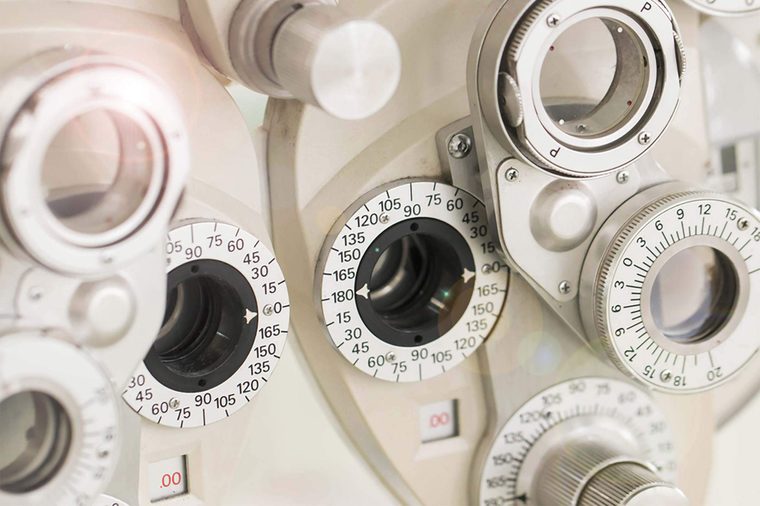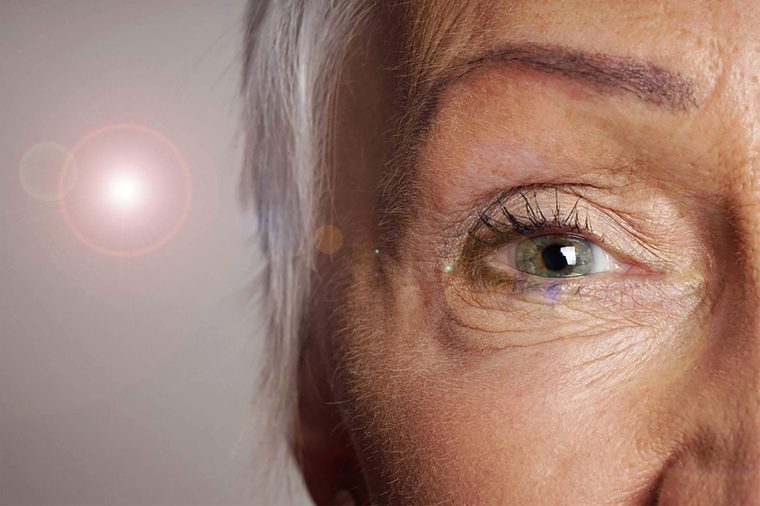What are eye cataracts?
Eye cataracts, an eye condition that affects 20 million Americans over the age of 40, is one of the most common eye disorders in the world. In fact, the Centers for Disease Control and Prevention (CDC) estimates that 30 million people will have cataracts by 2020. Cataract is a cloudy or opaque area on the crystalline lens of the eye that develops over time. Despite being so common, most cataract cases aren’t caught until they’ve progressed because they’re painless and the loss of sight is subtle. (Check out the 13 secrets your eye doctor wants you to know.) Either both or one eyes can suffer: To diagnose the condition, optometrists and other eye specialists look for a yellowing in the lens of the eye and an opacity in the back capsule.

Cloudy or blurry vision
First, always take steps to take care of your eyes—like employing these 13 vision boosting tricks. With cataracts, you might have a localized blurred spot or a generalized decrease in vision; either way, impaired eyesight will likely be the first thing you notice. A cataract will start out small and initially have very little effect on your vision, though you may notice the world beginning to resemble an impressionist painting or a cloudy piece of glass. “Blurry vision is the number one symptom of cataracts,” says Joseph Fishkin, MD, comprehensive ophthalmologist and cataract surgeon. “Blurred vision can be caused by many different problems but, as cataracts develop, vision gets more blurry over time. The natural lens in our eye helps light focus properly, and this normally clear lens slowly becomes more cloudy.” Because this is difficult to differentiate from other diseases such as glaucoma, it’s important to consult your optometrist as often as possible if you notice these changes.

Decreased color perception
Due to the clouding of the eye, colors can become less vibrant and increasingly muddy over time. “Real” whites will appear much more yellow in comparison. Because this occurs at such a slow and gradual pace, most patients won’t notice color changes until after surgery is done to remove one or both cataracts. (Help protect your eyes with these easy ways to improve your vision.) “When people develop cataracts, there is a marked fading or yellowing of colors, which is sometimes noticed,” says Michael Nordlund, MD of Cincinnati Eye Institute. “One of the most prominent improvements in vision after cataract surgery is a marked improvement in color vision. Patients often comment following surgery that they don’t ever remember seeing such vibrant colors. In fact, we are just restoring the color vision of their youth.”

Sensitivity to light and glare
You may notice that what used to be a comfortable level of light is now too bothersome and make you cringe. Lamps, headlights, and the sun will become your biggest nemesis, and the light emanating from them will fan out like a halo. Because cataracts scatter much of the light entering the eye, optometrists report that this symptom will be very common. “As a cataract develops, light does not have a clear path to the back of the eye, and it becomes increasingly difficult for a person to see clearly,” James Schumer, MD, ophthalmologist, says.

Difficulty driving at night
Because cataracts make it difficult to balance the contrast between the darkness and bright lights from oncoming traffic, most affected people will experience trouble driving at night. If blaring headlights and luminous streetlamps are giving you a headache, you may want to get checked out, notes Shoshana Ungerleider, MD, internal medicine physician at Sutter Health’s California Pacific Medical Center. “Patients often complain of a problem with night driving and reading road signs. If you notice these and/or frequent changes in your eyeglass or contact lens prescription, make an appointment to see your eye doctor for an exam.”

Trouble reading the fine print
The first thing to check if you’re having trouble making out the small stuff is one of these seven signs you may need reading glasses. If that doesn’t help, then cataracts could be the cause. According to the American Optometric Association, the lens inside the eye is comparable to a camera lens, focusing light onto the retina and letting us see things clearly. This lens is mostly comprised of water and protein, and the protein is arranged in such a way that allows light to pass through it. Because cataracts cause the protein to clump together, small print may become difficult to discern in the eye’s refractive mirror. Scott MacRae, MD, ophthalmologist and chairman of the Public Health Committee with the American Academy of Ophthalmology, cites blurry or waxy reading and distance vision as one of the blaring signs of cataracts. “Things start to look like there is a film in front of your eyes. The sharpness is gone.”

Double vision
Diplopia, more commonly known as double vision, can be another silent sign of cataracts. However, this is not to mistaken as the diplopia that comes from improper alignment of the eyes. The double vision, in this case, will occur even when looking through one eye. “At first, the cataract may cause cloudiness in one’s vision that will affect only a small part of the eye’s lens and may not be so noticeable,” warns Dean Hart, OD, optometrist and professor at Columbia University’s School of Medicine. “But as the cataract grows in size, it will cloud more of the lens and will also distort the light passing through it. As a result, you may get double vision in a single eye if only that eye has the cataract.”

Frequent changes in eyeglass or contact lens prescription
When a nuclear cataract first develops, it can actually spark a temporary improvement in your near vision, often referred to as “second sight.” As a result, people who formerly needed reading glasses may no longer need them anymore (this improvement will eventually end), or frequent increases in the strength of your prescription glasses may be required. (You may want to rule out the seven signs you need new glasses that have nothing to do with blurry vision.) This indicates that the density of the lenses in your eyes is changing. Don’t take this a sign that you can forego your next eye doctor appointment, however; only a doctor can determine whether your sudden eye improvement is due to an eye cataract or an impromptu miracle. “Since these are silent symptoms, it is important to have an annual eye exam because cataracts are diagnosed through high magnification and high illumination examination of the lens,” notes Monica Nguyen, OD. “There is no proven approach to preventing cataracts, but there are preventative strategies, such as UV protection to reduce sunlight exposure, nutritional supplements (antioxidant vitamins and green leafy vegetables), and decreasing or quitting smoking.”
